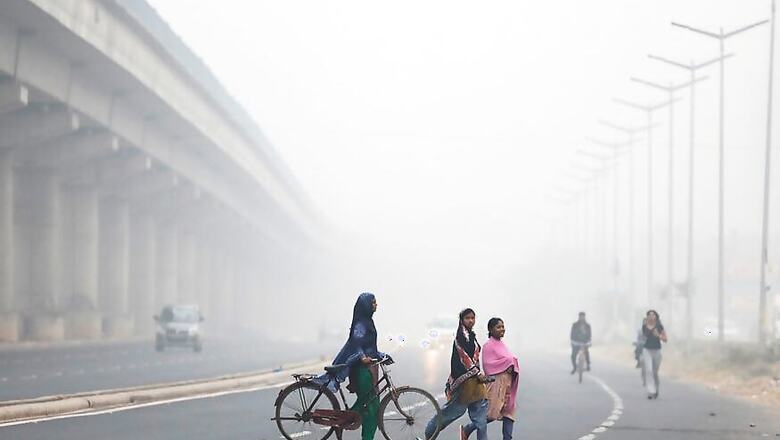
views
Delhi’s pollution episodes at this time of the year have become an annual affair - the latest one has the Chief Minister comparing Delhi to a gas chamber.
Like Los Angeles and Mexico City, Delhiites are cursed by geography to be prone to a meteorological phenomenon called inversion where warm air rests above the colder air closer to the ground, preventing it from mixing upwards thereby trapping all that we put into it – almost like a lid. This lid extends across the Indo-Gangetic plain through much of the winter months, leaving it covered in a haze and exposing millions to bad air quality.
During the months leading up to the monsoon, much of this semi-arid region is dry and dusty winds from as far away as the Sahara and Arabian deserts and our own Thar Desert bring in mineral dust. This dust subsides after the monsoon rain and lead to a few months of relatively clean air. As the monsoon retreats and high-pressure area forms over North India, our pollution levels creep up.
This pollution is a toxic mix of mineral dust (kicked up by construction activity and road traffic), soot, carbon monoxide, ozone, oxides of Sulphur and Nitrogen, and a host of other chemicals. Most of these pollutants are a result of combustion – of things we burn for various reasons.
While natural dust tends to be larger in size, the products of combustion react to form particles small enough (‘PM2.5’ or less than 2.5 microns diameter) to penetrate through to the lungs and enter our blood stream causing a myriad of health problems. Air pollution is the leading environmental cause of death worldwide and results in 1.1 million early deaths in India according to the Global Burden of Disease report.
Humans have been burning things for a long time now – to clear land for agriculture, for cooking and heating, and powering the industrial revolution. The products of this burning can travel far and affect remote places. Scientists have found evidence of pollution from foundries and smelting dating back to the early Roman Empire in ice samples from Greenland, and in the blackened lungs of mummified bodies in Egypt and England. And historians have recorded that Roman courts considered civil claims over smoke pollution 2,000 years ago and under Emperor Justinian in 535, even tried a very early version of the Clean Air Act.
The advent of the industrial revolution and the large-scale exploitation of fossil fuels greatly increased air pollution and the post World War II boom led to severe episodes such as the Great London Fog of December 1952 that is estimated to have killed at least 4,000 people and by some estimates as many as 12,000.
The recognition of pollution resulting from automobiles and industries in places across Europe and the United States (especially Los Angeles) led to the development of emission control regulations and technology. The ensuing decades have seen much of the visible pollution from the western cities cleaned up.
Air pollution also impacts our climate in many ways. The small particles resulting from burning fossil fuels like coal and oil consist mainly of sulphates that tend to reflect sunlight leading to less of it reaching the ground – what scientists call “dimming” - and actually lowers the temperatures.
Some of the temperature rise we have experienced from increasing greenhouse gases (again mainly from burning fossil fuels) has been offset by these particles. Take away the pollution and we will actually see faster increases in temperature – as many European and North American cities that cleaned up are.
But there are more insidious effects of pollution on climate. The dimming effect is reducing how hot the Indian land mass gets and this, in turn, reduces the strength of the monsoon. The small particles serve as the nucleus around which cloud water droplets form – and the over-abundance of particles changes the behaviour of clouds and how they produce rain.
There is mounting evidence that these two effects may have resulted in a steady decrease of rainfall in the core monsoon region of India. A substantial portion of pollution in India also contains soot or “black carbon” that absorbs sunlight (unlike the sulphate particles) and these can actually “burn off” clouds by re-evaporating the water droplets. Soot has also been found deposited on snow and ice in high mountain areas where they can actually hasten melting. Couple this with the direct effects of ozone and black carbon pollution on agriculture (wheat crop losses alone are estimated to be between 5-15%) and you have a fairly grim set of consequences of air pollution.
Along with the health consequences of pollution, the reduced monsoon rainfall, enhanced melting of snow and ice, and agricultural losses should make us sit up and notice that what we have here is not just a week or two of discomfort, but a long-term change to the very natural systems that sustain us.
(Krishna AchutaRao is an associate professor at Centre for Atmospheric Sciences, IIT Delhi. Views are personal.)



















Comments
0 comment